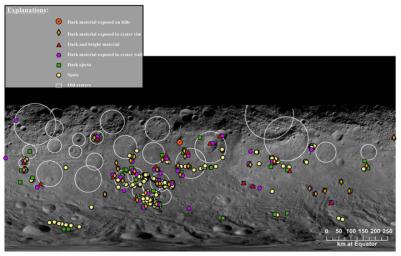
|
Map of Dark Materials on Vesta
- Click the image above for a larger view
- Full-Res JPEG (926 x 591) (91.8 kB)
- Full-Res TIFF (926 x 591) (1.6 MB)
Caption:
This map is a mosaic of images obtained by NASA's Dawn's framing camera during the high-altitude mapping orbit phase. The average altitude of this phase was 420 miles (680 kilometers).
This map shows the distribution of dark materials on the surface of Vesta. The symbols on the map mark the different varieties of dark materials. Some appear as localized deposits in the form of dark-rayed impact craters; others are localized outcrops on the walls, rims and flanks of impact craters and on isolated hills. There are also regional deposits such as the fields of material ejected from craters during impacts.
Background Info:
The Dawn mission to the asteroids Vesta and Ceres is managed by NASA's Jet Propulsion Laboratory, a division of the California Institute of Technology in Pasadena, for NASA's Science Mission Directorate, Washington. Dawn is a project of the directorate's Discovery Program, managed by NASA's Marshall Space Flight Center in Huntsville, Ala. UCLA is responsible for overall Dawn mission science. The Dawn Framing Cameras have been developed and built under the leadership of the Max Planck Institute for Solar System Research, Katlenburg-Lindau, Germany, with significant contributions by DLR German Aerospace Center, Institute of Planetary Research, Berlin, and in coordination with the Institute of Computer and Communication Network Engineering, Braunschweig. The framing camera project is funded by the Max Planck Society, DLR, and NASA/JPL.
More information about the Dawn mission is online at http://www.nasa.gov/dawn and http://dawn.jpl.nasa.gov .
Cataloging Keywords:
| Name | Value | Additional Values |
|---|---|---|
| Target | 4 Vesta | |
| System | Main Belt | |
| Target Type | Asteroid | |
| Mission | Dawn | |
| Instrument Host | Dawn | |
| Host Type | Orbiter | |
| Instrument | Framing Camera (FC) | |
| Detector | ||
| Extra Keywords | Color, Crater, Impact, Map | |
| Acquisition Date | ||
| Release Date | 2012-03-21 | |
| Date in Caption | ||
| Image Credit | NASA/JPL-Caltech/UCLA/MPS/DLR/IDA/UMD | |
| Source | photojournal.jpl.nasa.gov/catalog/PIA15238 | |
| Identifier | PIA15238 | |
